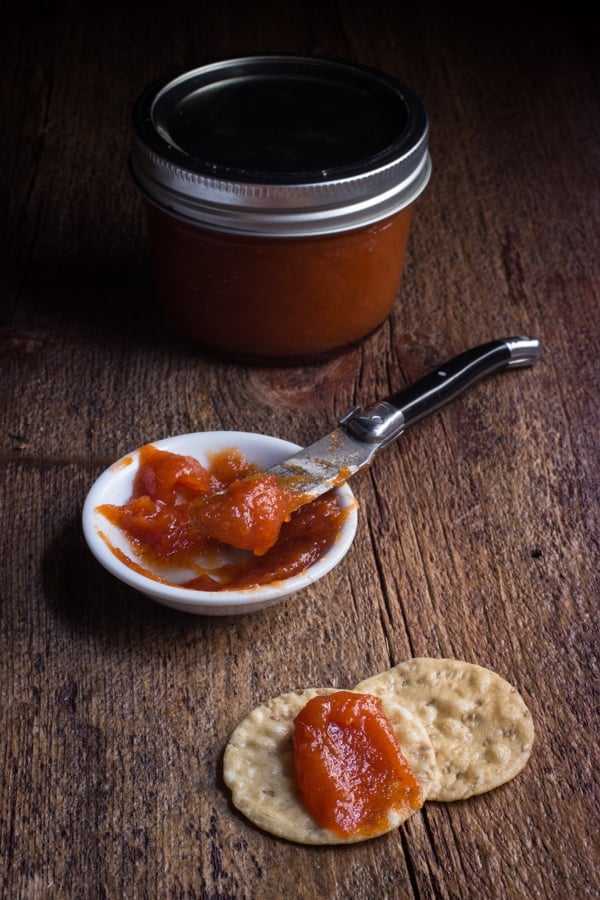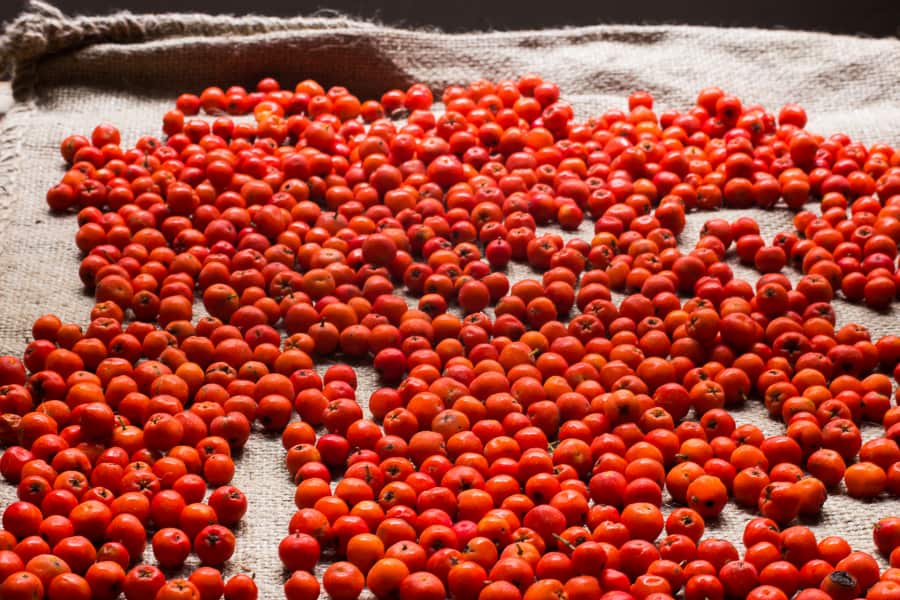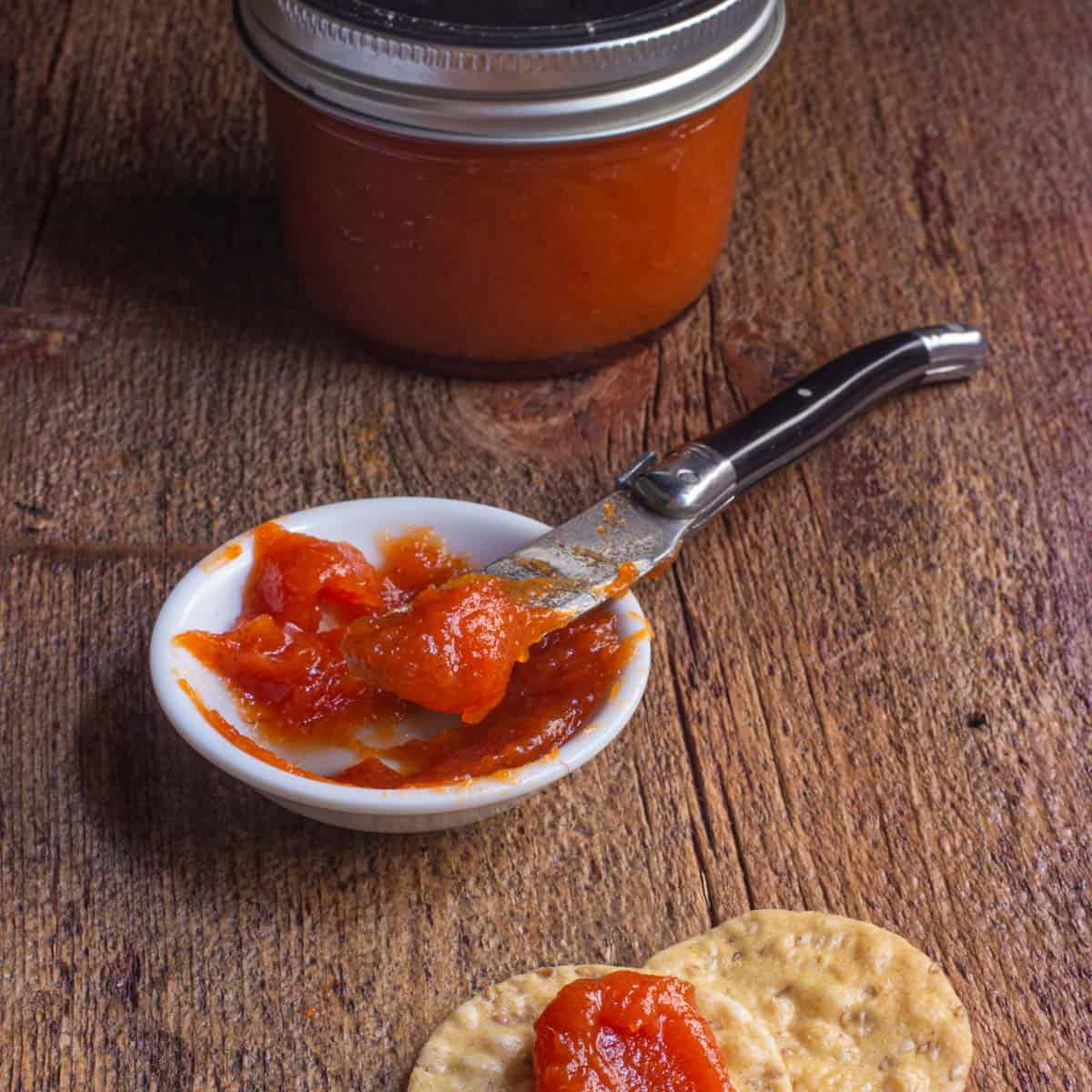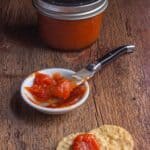A simple jam made from rowanberries and apples. If you like the taste of rowans, you'll love this. If you don't, it'll grow on you.

The rowan berries will be ready soon. Last year I shared my favorite method for preserving them in syrup, which makes them taste a bit like cranberries, and curbs their bitterness so much you can eat them right from the jar, after a while.
Sometimes I don't want to wait. Also, gathering food for the restaurant and working long shifts takes it's toll on my free time, so when I do go out to hunt goodies for the restaurant, I try to stretch ingredients for all they're worth.
I came up with this jam as a way to use rowan berries right away, but also to stretch them, since when you combine them with the apples, you get a lot of yield from just a small amount of berries.

Cranberries are paired with apples to mellow their tartness. Rowan berries are similar, but much more bitter. The key with them is figuring out a way to curb their punch, and enhance their fruity-ness. Traditionally, jellies are made from rowan berries, but jellies often have way too much sugar for my taste.
I tend to stray towards sweet jams and thick fruit purees that utilize the skin of the fruit as a thickener. This means that you have to deal with the high amount of natural, mouth-drying tannin in the skins of fruit, but with a little effort, it can be mellowed, not removed, but mellowed.
That being said, the mechanics of the jam are simple. Cook some apples and rowan berries together, pass through a food mill, reduce. That's it. The apples mellow the tannin and bitterness of the berries, but the jam retains enough of their flavor to make it interesting, and it definitely isn't too sweet.
Pick your berries after a frost
The flavor of rowanberries is drastically improved by a few cold frosts. I don't even think of harvesting them anymore before it gets cold.
Different species, different levels of bitter
Know that there are different species of mountain ash, and they definitely taste different. One tree I pick from has very small berries that I can eat straight from the tree and barely taste any bitter, some are incredibly bitter raw. I'm a chef, not a botanist, so I can't speak to all the different types, but don't be discouraged. If you have some property, you might think about getting a European strain, but you're on your own there. In the end, there will be some bitterness, if that scares you, refer to the rowanberries in syrup.

Rowan Berry-Apple Jam
Equipment
- 3 quart sauce pan
- Blender
Ingredients
- 1.5 cups ripe rowan berries picked after a couple hard frosts
- 1 cup white granulated sugar
- 5 cups diced firm apples like braeburn, fuji, honeycrisp or granny smith, peeled and diced
- 1 tablespoon fresh ginger roughly chopped, or more to taste
- Pinch of salt
Instructions
- Cook all ingredients on medium heat in a non-reactive pot until soft, about 30 minutes, stirring occasionally. If the pan gets dry, add a tablespoon or so of water.
- Pass the mixture through a food mill. Put the jam into a labeled, dated container, then freeze or refrigerate until needed.
- If the jam looks watery, put it back on the heat and cook gently to dry it out until it thickens. The jam will keep in the fridge for a week or two and will mellow with time.


Jennifer
hi there, I suppose this could be water bath canned too?
Alan Bergo
Sure
Erin
Regarding the multiple hard frosts. For the same reason winter carrots and radishes are sweeter than their summer counterparts, you must allow nature to do its work before harvesting the berries. As the temperature lowers, plants naturally send out sugars to protect themselves from the frosts. The sugar water freezes at a lower temperature and thus provides the plant protection from the cold while making the fruit more palatable to us humans (and apparently the birds too!).
Thank you for your interesting and informative posts on the Rowan berries. I live in N. Idaho and have a huge tree in my yard. I'm eager to try using the berries.
Alan Bergo
Thanks Erin, the jelly is by far my favorite thing to make with them-I'd try that first.
Heather
Do you think this would taste good as a pear/rowan spread? We just bought property, and we have two heavily fruited pear trees. I don't know what to do with it all!
Alan Bergo
Sure
Annie Cannon
I'm wondering if freezing the berries right after picking will work in place of waiting for a natural frost
Alan Bergo
Negative. You need multiple hard frosts. I suppose you could experiment with taking them out and putting them back in, but it seems silly to me. I just wait.
Christine Duffy
Thank you for this recipe, this is my first time using rowan berries, lots of them here in Ireland. I had read in another recipe about freezing first, but multiple freezes sounds better and at this time - living in two locations, it suits me to do that, so thanks for heads up.
Linda Crerie
I used your recipe, but I added vanilla, maple syrup, and lemon juice...and it is delicious!
I pureed everything together, and I had to try this jam in a cup of tea...OMGOSH, it's amazing fruity and smooth.
Thank You for sharing your recipes with us.
Alan Bergo
Thanks Linda.
Marie
Hello, I would like to make this Rowan berries and apple jam, leaving the pulp, not putting the purée through a food mill or blender. This is because I believe in using the whole fruit, if possible. Is that going to be a problem with this berry? Thank you for your input. Kind regards.
Alan Bergo
It's not going to be a problem.
Gary T Britton
I had a recipe about 3 years ago and made a huge batch. Last year our Ash Tree did not produce well and the wild Turkeys stripped my Apple Tree so never made a new batch. This year I have a ton of Ash Berries and only Two Jars left. I have LOST that recipe and am very sad. Today, I found yours and it looks a lot like what I used 3 years ago with the 4 spices and orange. I Can mine and think I used water bath method. I do have to add vinegar as I have very hard water. What I need to know is "How long do I leave it in the water bath and/or the Pressure Canner?"
Gary T Britton
...and what headspace would you use???
Alan Bergo
For small half pint jars like the one pictured, about 12-15 minutes is fine. For the headspace, just fill the jars up until the line under the cap, about 1/2 inch. Hope that helps.
Gary
Thank you very much! Just waiting for a good frost! My Ash tree is LOADED! Branches are sagging with all the berries!
Deborah
The photo resembles the apple and pear "butters" I remember from my childhood. My mom always warned us off the Mountain Ash berries, so I'm happy to see this recipe! We too prefer slightly tart jams and jellies.
Alan Bergo
Hi Deborah, yes, this comes out a bit like apple/pear butter, its definitely on the mild/savory side.
WillK
What a great idea, combining them with apples. I might give this a try with deerberries (aka "squawberries", Vaccinium stamineum) next season.